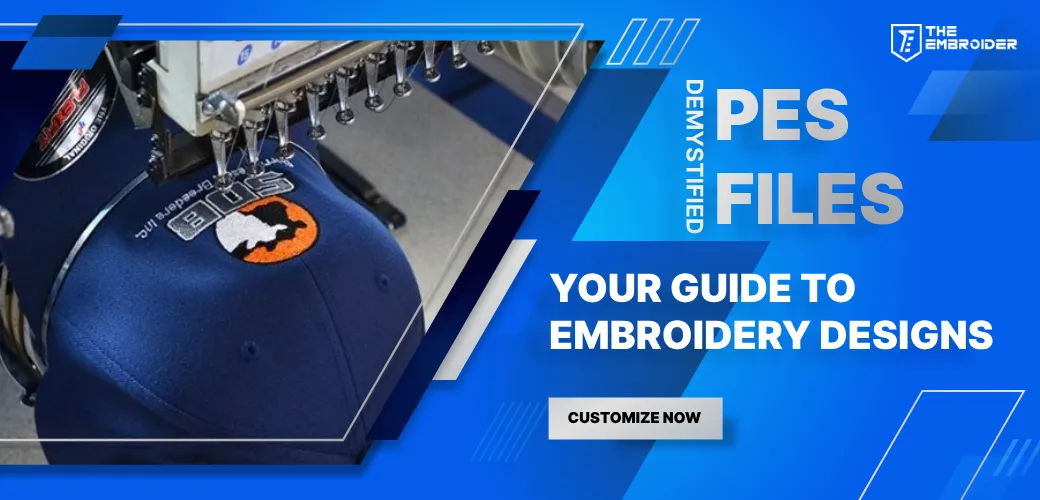
PES Files Demystified: Your Guide to Embroidery Designs
Navigating embroidery file formats can be tricky, especially if you're new to the craft or
have encountered compatibility issues.
This guide is here to demystify embroidery file formats, with a special spotlight on PES
files for embroidery, to help you streamline your embroidery projects and make the most of
your machine’s capabilities.
Getting Started with Embroidery File Formats
Embroidery file formats are
specialized digital formats
for the purpose of: Manage and interpret designs.
These files contain information about stitching patterns,
tain information about stitching patterns,
other details necessary for an embroidery machine to precisely ‘’recreate the design’’.
Why Do Embroidery File Formats Matter?
-
Accurate Interpretation:
They ensure your designs are interpreted correctly by your embroidery machine.
-
Each format Specific Instructions:
provides detailed instructions on
-
How to stitch the design
-
Which colors to use
-
How to handle various pattern elements
-
Seamless Execution:
Proper file formats ensure your machine accurately brings your designs to life without
errors.
Popular Embroidery File Formats
DST (Tajima)
-
Popularity
One of the most widely used in the embroidery industry
-
Origin:
Developed by Tajima
-
Compatibility:
Works with most embroidery machines
-
Type:
: Stitch-based format, storing data for each stitch in the design
PES Format:
-
Frequently used
Common Use:
by Brother and Bernina machines
-
Features
upports multiple thread colors and advanced stitching techniques
-
Advantages:
Known for its versatility and ease of use
Selecting the Best Embroidery File Format
-
Machine Compatibility:
Check which formats your embroidery machine supports, as different machines work
with different
file types.
-
Design Complexity:
Consider the complexity of your design and the features you need. Some formats offer
advanced
stitching techniques and color variations.
-
Consult Documentation:
Ensure the file format you choose is compatible with your machine by referring to your machine’s
manual or the manufacturer’s website for supported formats.
Reasons to Convert Embroidery File Formats
There are situations where converting an embroidery file from one format to another
becomes necessary. This may occur if:
-
The design does not align with your machine’s format requirements.
-
You’re collaborating with someone who uses a different machine.
For example, if you have a design in DST format but need it in PES, a DST to PES
file
converter
is crucial.
Tools and Software for Conversion
There are various tools and software available for converting embroidery file formats.
Some popular options include
These tools enable you to open a design in one format and save it in another, ensuring
it works with your machine.
Whether you need to convert SVG to PES or use a PNG to PES file converter, these
programs will be very useful.
Fixing Common Embroidery File Issues
Corrupted Files
One common issue with embroidery files is corruption. This can happen if the file needs
to be downloaded or transferred correctly. To fix a corrupted file, try downloading it
again or using a file repair tool.
Incompatible Formats
Another common issue: using an incompatible file format.
If your machine doesn’t support the ‘’format of your design’’, you’ll need to convert it
to a compatible format using
’conversion software’’.
Tips for Managing Embroidery File Formats
Organizing Your Files
-
Create a Naming System
Use clear and descriptive names for your files.
-
Categorize Files:
Arrange files into folders based on categories like design type or project.
-
Establish Storage:
Develop a systematic approach to storing your files for easy access and management.
Protecting Your Designs
-
Frequently back up your embroidery designs to avoid losing them due to computer
malfunctions or other issues.
-
Safeguard your designs by: utilizing external hard drives, cloud storage, or both.
Need Help with Design Files?
Embroidery digitizing
service
a better option in case you find the process overwhelming. Let the experts handle it for
you!
Vector art services
another suitable option to help you create high-quality vector designs.
Opt to
convert images to vector illustrator
for best results.
Conclusion
Grasping embroidery file formats is key for anyone working with machine embroidery. By
learning about the various formats and their features, you'll ensure that your designs
are
compatible with your machine and achieve the best results.
-
Try New Things:
Don’t hesitate to explore different formats and tools to find what suits you best.
-
Choose the Right Tools:
Whether it’s a PES file converter or software to
convert SVG to PES,
getting comfortable with these tools will greatly enhance your embroidery projects.
Embroidery merges art with technical skill. By understanding the technical details, you
can focus on your creative process and bring your unique designs to life with both
precision and style. Happy stitching!

